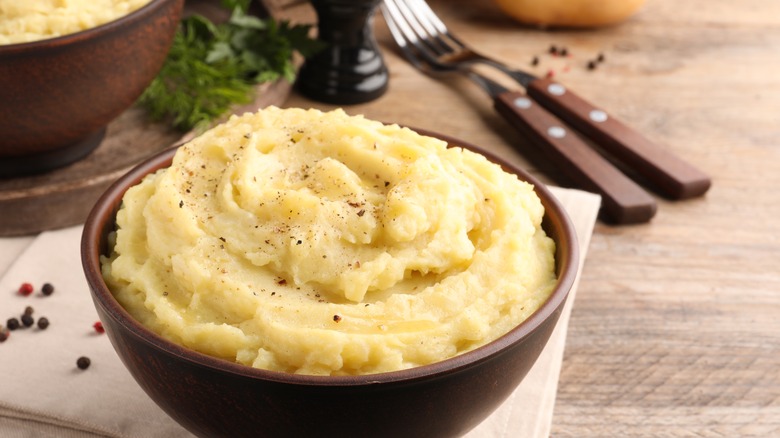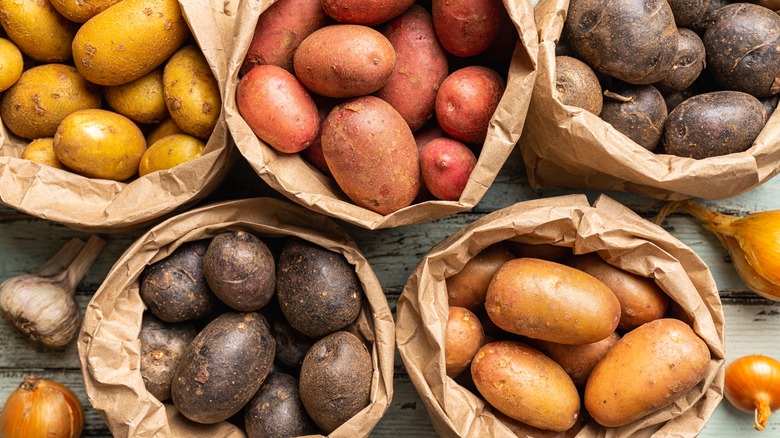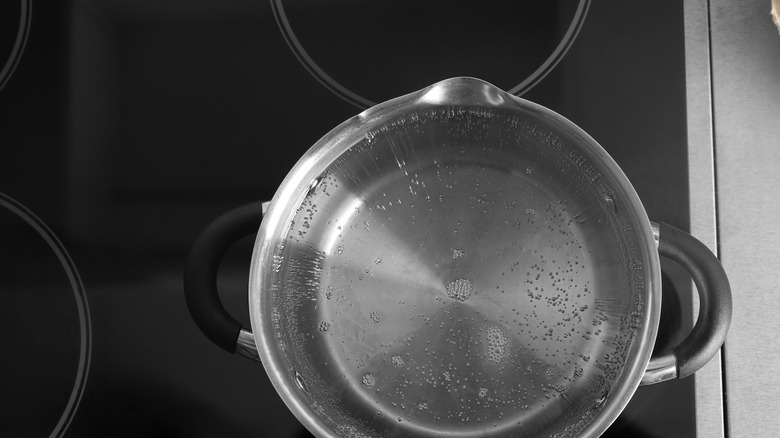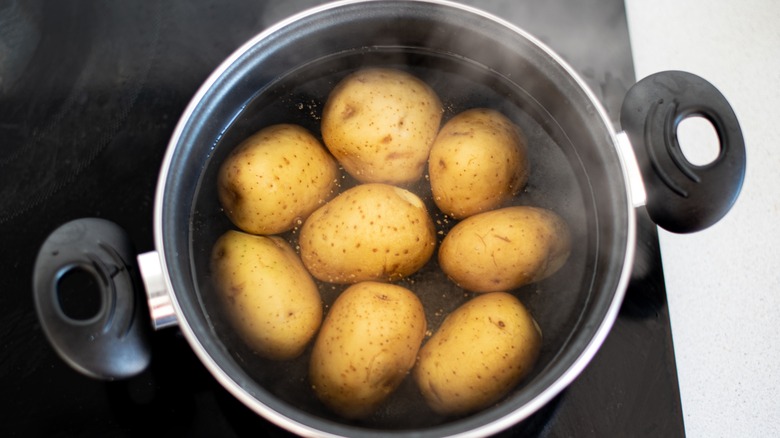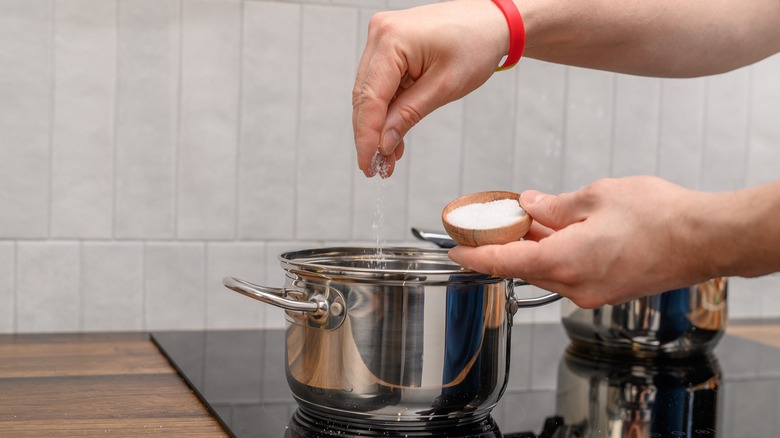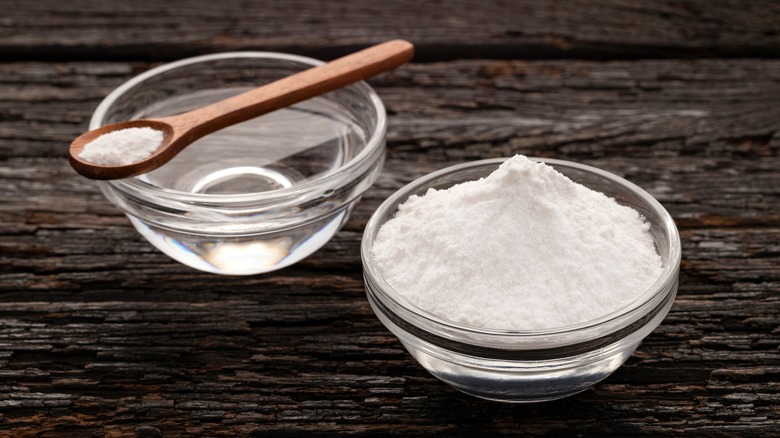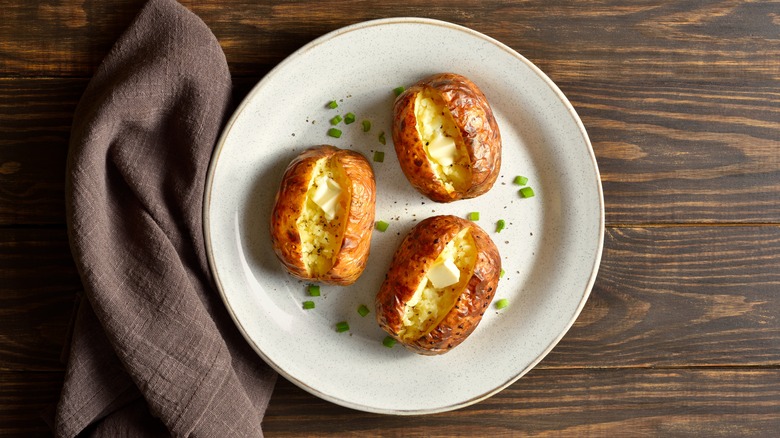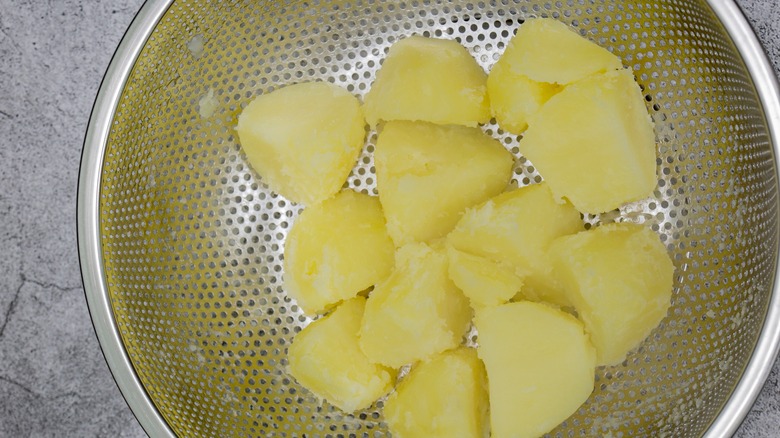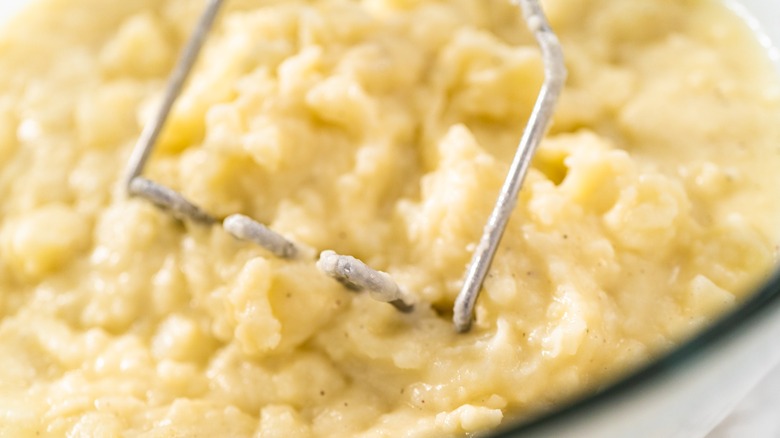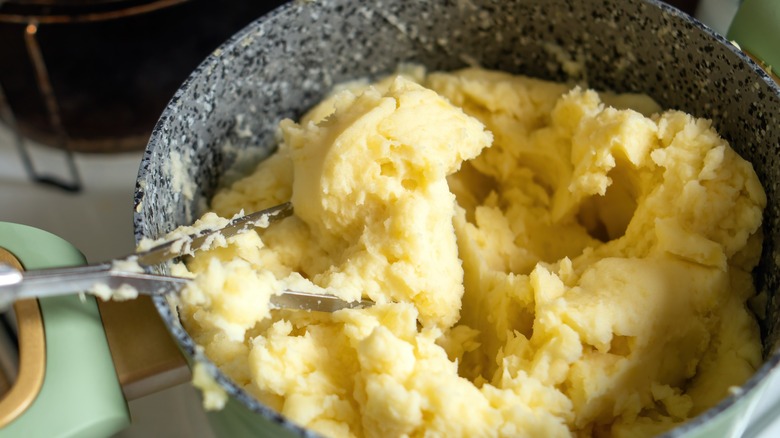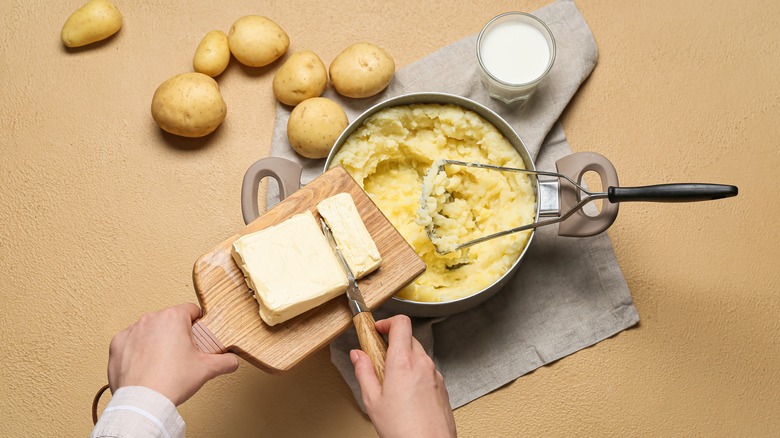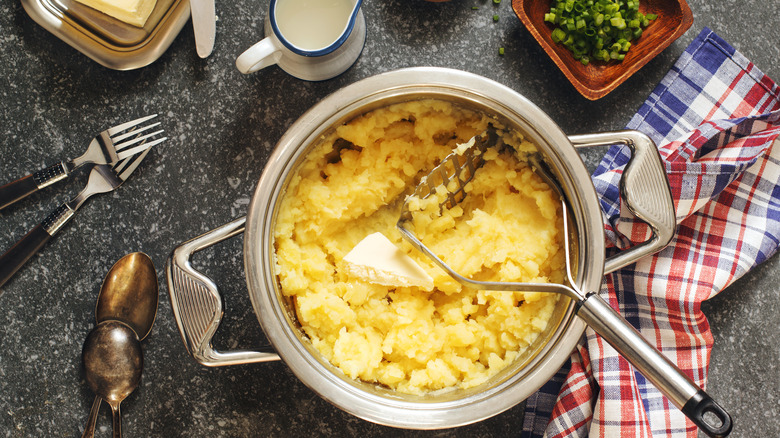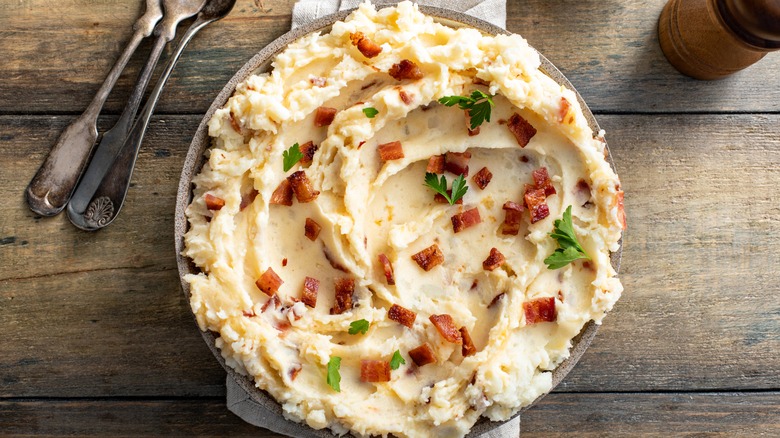12 Tips You Need When Cooking Mashed Potatoes
We may receive a commission on purchases made from links.
Mashed potatoes are like the comfort blanket of side dishes — you know you can always rely on them whether you're serving a quick midweek meal or a Thanksgiving turkey. There is a big difference, however, between average mash and great mash, and you should always be aiming for the latter.
To help elevate your mashed potatoes from humble side dish to superstar accompaniment, I asked several experts to share their best tips. Erin Clarke is the author of "The Well Plated Cookbook" and "Well Plated Every Day;" Holly Nilsson is the founder of Spend With Pennies and author of "Everyday Comfort;" and Cynthia Christensen is the owner/recipe developer at But First We Brunch. Shane Graybeal is executive chef at Fielding's at The Armory Hotel; Jack Bennett is executive sous chef at International Smoke in San Francisco; and Sarah Bond is the food scientist, nutritionist, and recipe developer behind Live Eat Learn. Between them, they have made more than their fair share of mashed potatoes and understand how to elevate the simple dish to new heights. From choosing the best variety of potatoes to getting the temperature right, they share the tips and tricks to level up your spuds. So, go find your potato masher, and let's dive in.
Choose the best variety of potatoes
The first crucial step in making a successful mash is to choose the correct variety of potato, getting the perfect balance between starch content and buttery flavor. Potatoes fall into one of three categories: starchy, waxy, and all-purpose, the latter of which lies somewhere in the middle. "You definitely want to avoid waxy potatoes, which are higher in moisture and have lower starch," explains Cynthia Christensen. The low starch content of waxy potatoes means they will end up gummy rather than fluffy.
Holly Nilsson favors Yukon Gold for the perfect mash, thanks to their medium starch content and buttery flavor, and Erin Clarke agrees, pointing out that "more butter is a good thing when you're talking mashed potatoes." As they don't take on too much water as they cook, you won't have the issue of water-logged mash that other potatoes could result in.
If you don't have the favored Yukon Gold to hand, try another all-rounder, such as Kennebec, which Jack Bennett considers a good alternative. However, he recommends avoiding one variety that you might already have in your pantry — russet potatoes — as they can result in watery mash. "They take on a lot of water in the cooking process and are much better in other dishes," he explains. So, if you want to create delicious mashed potatoes, take some time at the grocery store to choose a variety that will give you buttery and fluffy results every time.
Start with cold water
Boiling the potatoes before mashing them should be the easy part, but you may be making a critical error from the outset. Rather than adding boiling water to the pan and then throwing the potatoes in, you should add them to cold water and gradually bring them up to temperature. Avoid boiling them, though; as Jack Bennett explains, "This starts a reaction with the starch inside the potato that leads to the mash being gummy."
Cynthia Christensen advises the same, explaining that starting with cold water will allow the potatoes to cook evenly. "Dumping raw potatoes into already boiling water will cook the outside quickly; the insides will possibly be raw, while the outside will be overcooked," she points out.
Once the water has reached a gentle boil, you can then reduce the heat and allow the potatoes to simmer gently. This may take a little longer, but the texture of the potatoes at the end will be vastly improved. "After your potatoes have come to a boil, simmer them for 10 to 15 minutes, or until they pierce easily with a skewer or a fork," suggests Christensen.
If you are surprised at the suggestion to use cold water and have always used boiling water for all your veggies, here is a simple rule to remember. If it grows underground, start it in cold water; if it grows above the ground, boil the water first. This helps to successfully break down the starch in root veggies, which isn't needed in the more tender vegetables.
Boil with the skins on
When preparing potatoes, one of the big questions is usually: skins on or off? When it comes to mash, there are a few aspects to consider when deciding whether to use naked potatoes or not, but Shane Graybeal suggests that the decision shouldn't be made until after you have cooked them. "I never boil a peeled potato," he says. "You want that skin to be intact for flavor and protect the starch from bleeding into the water." Leaving the skins intact can also stop your spuds from absorbing too much water, helping avoid the nightmare of soggy mash.
Once the potatoes are cooked, you can then decide whether to leave the skins on, creating texture and more interesting flavor, or remove them for a silky smooth mash. Cynthia Christensen points out that you may want to make this decision depending on each individual situation. "Whether you peel or don't peel your potatoes is a matter of preference," she suggests. "Sometimes I want rustic, lumpy potato with bits of peel in it, and sometimes I want something more akin to a Robuchon potato, which is ultra smooth and creamy." If you're in the mood for a homely mash with some earthy flavor, skin-on is the way to go. But for a fancy dinner party where you want to impress, you may wish to get those potatoes out of their jackets — after they have cooked, of course.
Season the cooking water well
We all know we need to season our potatoes before mashing them, but when is the best time to do it? Before cooking, during, or after — or all three? Well, if you have ever tasted a potato that has been cooking in stock when you make a soup, you will know that it absorbs flavor really well. So waiting until the potatoes are cooked to add seasoning means you are missing out on the chance to get real flavor into them. "Salt the potato cooking water well — this is key to seasoning the potatoes deeply from the inside out," advises Erin Clarke. "If you wait to season them until after they are mashed, they'll just taste salty."
The cooking liquor is your opportunity to transform your potatoes before they get to the mashing stage and meet with cream, butter, or cheese. As well as salt, you could try adding woody herbs into the water as they cook, allowing them to soak up the aromatic flavor from the water. Rosemary and thyme work well, or add a bay leaf if you have one. After the potatoes are cooked, you can still add seasoning, including salt, but be aware that this will add stronger flavor and make them taste salty in a way that the subtlety of the seasoned water won't.
Add baking powder
If you're looking for a neat tip to make your mashed potatoes even fluffier, take inspiration from your baking adventures. While baking powder is often used in muffins and bread to create airy baked goods, it can be put to similar use with your spuds. "Add a pinch of baking powder to the potatoes before mashing," suggests Sarah Bond. "It creates tiny air pockets, making your mashed potatoes extra light and fluffy (without any difference in taste)!"
To utilize this helpful hack, simply sprinkle a little baking powder over the top of the freshly boiled potatoes before mashing them to the desired consistency. This is a great way to add a fluffy texture to your mash if you don't want to add dairy for any reason. It is also an excellent option if you decide to make mash at the last minute and don't have some of your usual additions in the fridge. Your trusty baking powder will be sitting in your pantry, waiting to come to your rescue.
Consider baking
Though boiling may be the most common method of cooking potatoes before mashing. It's not the only option. Baking can be just as effective, and also economical if you are using the oven for other ingredients at the same time. Shane Graybeal suggests you can even bake them the day before, then heat them up to mash them. "This allows the starches to 'set' and gives them a great flavor and texture," he explains.
If you've had problems with watery mash in the past, baking the potatoes could be a great option to improve the texture. Baked potatoes have a different flavor from boiled too — even before you add a lashing of bacon and sour cream, a baked potato is a tasty spud. Although this method may take a little more forward planning, it is pretty hands-off, and you can leave your potatoes to bake for an hour or so while you prepare other ingredients — or put your feet up and have a cuppa.
Remove excess moisture
Soggy mashed potatoes are the nightmare of side dishes, with the excess water flushing away the flavor and ruining the texture. If watery mash is a regular feature of your midweek meals, fear not. It is easily fixed with some attention to detail after they have cooked.
Both Holly Nilsson and Sarah Bond highlight the need to drain the potatoes thoroughly and leave them for a few minutes to allow excess water to evaporate. Bond also has an extra tip that will ensure your spuds are dry and ready for the mashing stage: "Once you've drained the potatoes, return them to the hot pot for a minute or so to evaporate any remaining moisture (I like to shake them in the pot to really help that steam escape)," she says.
This drying step is crucial in ensuring a smooth and desirable texture for your mash — no one enjoys potatoes that have become gummy. By including this simple technique, your potatoes will be in prime condition to absorb all the delicious flavor they will be exposed to in the next stage of their journey.
Avoid over mashing
One of the big questions when cooking mash is how smooth the potatoes should be. As Cynthia Christensen points out, this is a personal preference and may change depending on the dish you are serving or the guests you are trying to impress.
For a rustic texture, a regular potato masher is fine, but go easy with it. "Too much mashing releases excess starch, turning your potatoes into a gluey mess," says Sarah Bond.
If smoothness is your primary goal. You may be considering the help of an electrical appliance — but choose carefully. "Your instincts might tell you to pull out the food processor, but resist that inner voice," urges Christensen. "[It] produces too much friction, which will break down all the starches in your potatoes, and that will turn them gummy and unappetizing."
Instead, for a professional touch, choose a tool that is designed for this task. "If you really want to go next-level, use a potato ricer," advises Erin Clarke. "It helps the potatoes blend together super smoothly and prevents overworking." Holly Nilsson agrees, advising against using a food processor or mixer that will spoil the texture. An old-school masher or fancy potato ricer is all you need for the perfect mash to suit any occasion.
Mash them while they're hot
As with so many things in the world of home cooking, timing can be everything when it comes to creating silky mashed potatoes. It can be tricky juggling multiple elements at once for one meal, and the mash may not be the priority as it is a side dish. But if you can avoid letting your potatoes cool too much before mashing them, you will find the texture is much improved. "Mash the potatoes while they are still hot," Erin Clarke recommends. "This keeps them from getting gluey."
The warm potatoes will be pliable, making it easier for you to achieve the smooth consistency you're looking for. Even if you have prepared the spuds in advance and allowed them to cool, reheat them for a few minutes before you get out your masher or ricer. If you're planning to add dairy — and you definitely should — it will also be easier to incorporate into hot potatoes rather than cold.
Be generous with the dairy — and heat it first
When it comes to adding extras to your potatoes, the experts I spoke to were all in agreement; unless you or your guests don't eat dairy, add plenty of it to your mash. "I don't consider it to be mashed potatoes without dairy!" reveals Shane Graybeal. "And the proper amount is until the potatoes don't hold anymore."
Though it is possible to get smooth and creamy potatoes without the addition of dairy, incorporating it is an easy way to improve both the texture and taste. "Adding milk and butter gives the potatoes a silky texture and a buttery flavor," confirms Holly Nilsson. "This is one place you don't want to skimp; use real salted butter and lots of it."
Another useful tip is to heat the butter, cream, or cheese before adding it to the mash. "Cold dairy can shock the potatoes, resulting in a less creamy texture," explains Sarah Bond. "Warm your butter and cream before folding them in to ensure a smooth, cohesive mash." While butter and cream may be the most classic option, don't overlook the power of a little cheese. Cream cheese can work really well for a subtle flavor and added richness, or a grating of mature cheddar or Parmesan can give the spuds a delicious umami punch. Grate it finely to ensure it disappears into the mash easily to create a sleek texture.
Take the pressure off meal prep by making the mash in advance
If you've ever hosted a dinner party or large family celebration, you'll be familiar with the panic of trying to complete multiple elements of a meal at the same time and get everything plated up and ready to serve. While the star ingredient of your entree will often have to be cooked to order, making side dishes in advance is a great way to take some pressure off on the day. Fortunately, mashed potatoes fall into the category of a dish that copes well with being prepared early.
"Mashed potatoes can be made ahead of time for big holiday meals and reheated on the stovetop with a splash of milk," explains Holly Nilsson. For best results, make your mash using the tips we've already discussed, then store them in an airtight container in the fridge. For small batches, you can reheat them in the pan, but for a bigger crowd, you may want to use the oven on low heat. You can still add a dribble of milk to loosen them up a bit and prevent them from drying out.
Another handy option is to make them a few hours in advance, then keep them warm in the slow cooker. Again, a little bit of extra liquid can keep them moist, and this means they will be ready for plating up when the rest of your main course is ready.
Be creative with your additions
If your previous idea of flavoring your mash consisted of a tiny knob of butter and a splash of cream, it's time to up your game. There are so many tasty and creative ways to jazz up mashed potatoes, and if your family is used to getting the same old safe potato dish every time, they will be delighted with the upgrade.
Shane Graybeal points out that mashed potatoes are a great vessel for other flavors, so don't be afraid to add some of your favorite ingredients. "My perfect potatoes are sour cream, cheddar, and green onions," he admits. "Add your cheese as soon you can, [then] sour cream to get the consistency you want, and then green onions to finish."
Holly Nilsson advises switching up the flavors in your mash depending on the dish you are serving them with. Consider what ingredients would usually match that dish, and add them to your potatoes. "Nothing beats a classic mashed potato with butter, cream, salt, and pepper, but if I'm serving them with steak, I often add a little horseradish, roasted garlic, or shredded cheese to the mix," she says.
Another reason to add strong flavors to your mash is to make up for sub-par potatoes. If you can't manage to get the best type of potato for mashing, you may be able to compensate with flavorsome additions. "If I'm stuck using a potato variety that is not a Yukon or Kennebec potato, I tend to add things to the mash — roasted garlic, bacon, and cheddar," explains Jack Bennett.
